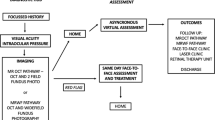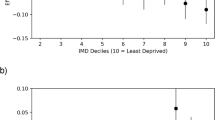Abstract
Background
Ophthalmology outpatient attendances have significantly increased recently with rising pressure from backlogs arising from the pandemic. Medical retina digital surveillance clinics for stable follow-up appointments are well established. We present a model for assessing new referrals and evaluating clinical outcomes and long-term sustainability in a complex high-volume medical retina service.
Methods
Suitable routine new patient referrals were identified from electronic referrals and referred to this new pathway. Structured history, visual acuities, and intraocular pressures were recorded, and widefield colour fundus and optical coherence tomography imaging were performed at a imaging hub for asynchronous consultant-led review.
Results
1458 patients were invited to attend over four months, with a 13.2% did-not-attend (DNA) rate. Common diagnoses included stable diabetic retinopathy (19.9%), early age-related macular degeneration (6.7%), central serous retinopathy (8.8%), and retinal vein occlusion (6.3%). 7 patients (0.05%) required urgent same-day review. 61 (5.0%) required urgent face-to-face (F2F) assessment within two weeks. A total of 727 (59.0%) were either discharged or remained in the virtual pathway following their first visit.
Conclusion
This study encourages the use of a digital model that efficiently assesses suitable newly referred medical retina patients in both complex and local eye unit settings. This decreased the need for F2F clinics and resources. Further patient satisfaction surveys for digital services are currently being evaluated to guide long-term sustainability of this model.
This is a preview of subscription content, access via your institution
Access options
Subscribe to this journal
Receive 18 print issues and online access
$259.00 per year
only $14.39 per issue
Buy this article
- Purchase on Springer Link
- Instant access to full article PDF
Prices may be subject to local taxes which are calculated during checkout


Similar content being viewed by others
Data availability
All data supporting the results are summarised within the manuscript.
References
NHS Digital. Hospital Outpatient Activity 2020-21. https://digital.nhs.uk/data-and-information/publications/statistical/hospital-outpatient-activity/2020-21#chapter-index.
Hospital Outpatient Activity 2019-20 - NHS Digital.
Royal College of Ophthalmologists. The Way Forward Age-Related Macular Degeneration and Diabetic Retinopathy Options to Help Meet Demand for the Current and Future Care of Patients with Eye Disease.
NHS. Ophthalmology – the hospital eye service in crisis; 2018. Accessed August 13, 2022. Available from: https://www.rcophth.ac.uk/wp-content/uploads/2019/01/RCOphth-A4-Census-Infographic.pdf.
NHS Digital. Hospital Outpatient Activity. 2018–19.
Sreelatha OK, Ramesh SV. Teleophthalmology: improving patient outcomes. Clin Ophthalmol. 2016;10:285–95. https://doi.org/10.2147/OPTH.S80487.
Faes L, Fu DJ, Huemer J, Kern C, Wagner SK, Fasolo S, et al. A virtual-clinic pathway for patients referred from a national diabetes eye screening programme reduces service demands whilst maintaining quality of care. Eye. 2021;35:2260–9. https://doi.org/10.1038/s41433-020-01240-z.
Lee JX, Manjunath V, Talks SJ. Expanding the role of medical retina virtual clinics using multimodal ultra-widefield and optical coherence tomography imaging. Clin Ophthalmol. 2018;12:2337–45. https://doi.org/10.2147/OPTH.S181108.
Kortuem K, Fasler K, Charnley A, Khambati H, Fasolo S, Katz M, et al. Implementation of medical retina virtual clinics in a tertiary eye care referral centre. Br J Ophthalmol. 2018;102:1391–5. https://doi.org/10.1136/bjophthalmol-2017-311494.
Hanumunthadu D, Adan K, Tinkler K, Balaskas K, Hamilton R, Nicholson L. Moorfields Medical Retina Virtual Assessment Study Group. Outcomes following implementation of a high-volume medical retina virtual clinic utilising a diagnostic hub during COVID-19. Eye. 2022;36:627–33. https://doi.org/10.1038/s41433-021-01510-4.
Webster P. Virtual health care in the era of COVID-19. Lancet. 2020;395:1180–1. https://doi.org/10.1016/S0140-6736(20)30818-7.
Wright C, Davey A, Elmore N, Carter M, Mounce L, Wilson E, et al. Patients’ use and views of real-time feedback technology in general practice. Health Expectations. 2017;20:419–33. https://doi.org/10.1111/hex.12469.
Kitamura C, Zurawel–Balaura L, Wong RKS. How effective is video consultation in clinical oncology? A systematic review. Curr Oncol. 2010;17:17–27. https://doi.org/10.3747/co.v17i3.513.
Host BK, Turner AW, Muir J. Real‐time teleophthalmology video consultation: an analysis of patient satisfaction in rural Western Australia. Clin Exp Optom. 2018;101:129–34. https://doi.org/10.1111/cxo.12535.
Tham YC, Husain R, Teo KYC, Tan ACS, Chew ACY, Ting DS, et al. New digital models of care in ophthalmology, during and beyond the COVID-19 pandemic. Br J Ophthalmol. 2022;106:452–7. https://doi.org/10.1136/bjophthalmol-2020-317683.
Kern C, Fu DJ, Kortuem K, Huemer J, Barker D, Davis A, et al. Implementation of a cloud-based referral platform in ophthalmology: making telemedicine services a reality in eye care. Br J Ophthalmol. 2020;104:312–7. https://doi.org/10.1136/bjophthalmol-2019-314161.
Sim DA, Mitry D, Alexander P, Mapani A, Goverdhan S, Aslam T, et al. The evolution of teleophthalmology programs in the United Kingdom. J Diabetes Sci Technol. 2016;10:308–17. https://doi.org/10.1177/1932296816629983.
Office for National Statistics (2019).
Author information
Authors and Affiliations
Contributions
PV: Primary author, literature review, data analysis MPMG: Development and implementation of the new patient pathway, discussion. EA: Development and implementation of the new patient pathway, discussion. RH: Development and implementation of the new patient pathway, discussion, senior author. TG: Development and implementation of the new patient pathway. LN: Development and implementation of the new patient pathway, discussion, senior author. LZH: Development of new patient pathway, data analysis, discussion, senior author.
Corresponding author
Ethics declarations
COMPETING INTERESTS
The authors declare no competing interests.
Additional information
Publisher’s note Springer Nature remains neutral with regard to jurisdictional claims in published maps and institutional affiliations.
Supplementary information
Rights and permissions
Springer Nature or its licensor (e.g. a society or other partner) holds exclusive rights to this article under a publishing agreement with the author(s) or other rightsholder(s); author self-archiving of the accepted manuscript version of this article is solely governed by the terms of such publishing agreement and applicable law.
About this article
Cite this article
Veeramani, P., Pilar Martin-Gutierrez, M., Agorogiannis, E. et al. Efficacy and Safety outcomes of a novel model to assess new medical retina referrals in a high-volume medical retina virtual clinic. Eye 38, 168–172 (2024). https://doi.org/10.1038/s41433-023-02653-2
Received:
Revised:
Accepted:
Published:
Issue Date:
DOI: https://doi.org/10.1038/s41433-023-02653-2



